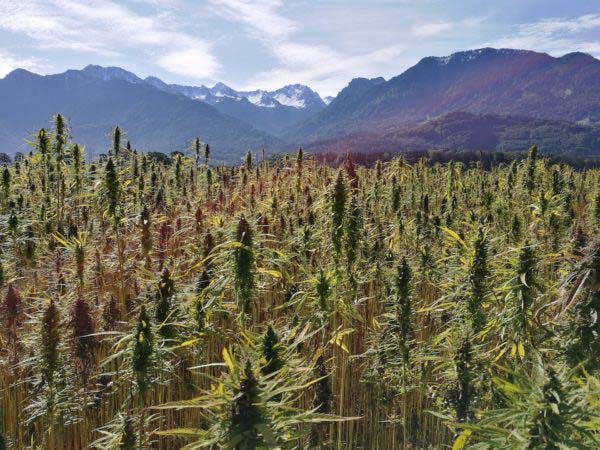Hemp for CBD-Based Products
The burgeoning industry around CBD extract used for everything from lotions, supplements, teas, oil tinctures seems to be influencing the number of growers focusing business around hemp production.
Hemp’s Current Boom
The Farm Bill 2018 included federal legalization of hemp and removal of hemp from the Controlled Substances Act. This means change to an industry long in coming, with a varied past in the United States. The rise of CBD-related products has given momentum to this industry which is currently seeing a boom in cultivation of hemp. Across the US, farmers who’ve typically grown more traditional vegetable crops are moving toward hemp. Let’s take a look at what is currently happening in this industry.
Brief History: U.S. Hemp Production
Entertaining a mottled history, some historians believe hemp has been produced or grown in North America since the time Jacques Cartier arrived on the Continent.
- Ancient History: – Hemp was probably the earliest plant cultivated for textile fiber. Archaeologists found a remnant of hemp cloth in ancient Mesopotamia (currently Iran and Iraq) which dates back to 8,000 BC.(1)
- In the 1600s – it was decreed by England that landowners in North America *had* to grow hemp for fibers used in textiles and rope.
- In 1937 – hemp production was banned throughout the United States with the passage of the Marihuana Tax Act.(2)
- During WWII, – faced with a shortage of hemp from Philippine sources under command of Japan, Congress enacted the ‘Hemp For Victory’ program meant to encourage farmers to grow hemp for fiber production during the war effort.
- In the 1950s – with the rise of rigid social mores, came stricter enforcement of hemp production based around its confused status as an illicit drug cousin of marijuana.
- From the 1960s through 2014 – social acceptance of illegal marijuana use widened in the U.S. while regulations around cultivation of hemp remained in a legal limbo.
- In 1970 – under the Controlled Substances Act, all forms of cannabis were made illegal at the Federal level.
- In the 1990s – the ‘Legalize Hemp’ movement advocated for hemp as something *other than* marijuana was socialized once again as a fiber, oil, or a protein. But the lack of wider legalization kept the cultivation of this very old crop to a minimum.
- The 2014 Farm Bill – quietly legalized hemp production within the framework of states’ ability to grow hemp “for purposes of research conducted under an agricultural pilot program or other agricultural or academic research” but left many holes in regulating production.
Hemp 2019: Farmers Need Seed
Currently, with the onset of legalized hemp production, there is focus on seeds, genetics and propagation. The business of large-scale, legalized ‘farming’ of hemp is just getting started. This production needs to be fueled at the ground level, so to speak: harvesting seeds and providing clones to growers of the larger plants which will be used for CBD extraction or for use in hemp fiber-based products. What growers really need right now are cultivars that will produce a product that has a specific (in many cases higher) CBD range along with a lower THC level.
How They Differ: Hemp & Marijuana
Hemp and marijuana are both Cannabis plants, but hemp has no more than 0.3% of THC(2), the psychoactive chemical that gets folks high. Marijuana has between 5-35% of THC. Hemp and marijuana are both cannabis. But they are different strains (reference). They also have different amounts of THC and CBDs and the amounts can vary depending on lots of growing and environmental factors. This is important because although hemp may be grown, if the level of THC exceeds 0.3%, the crop is viewed as marijuana and cannot be defended under federal law.
Greenhouses For Quality Hemp
Federally, industrial hemp has been approved with Farm Bill 2018. And many growers are already growing or getting started on growing the crops outdoors. Growing hemp for industrial use such as fiber is best done outdoors because of the lower cost. Hemp used for textile or rope seems almost mundane compared to what is happening with it’s legally murkier by-product, CBD.
CBD Going Mass Market
CBD’s use as an additive in everything from lotions or candy to drinks and supplements remains in a gray zone. CBD is currently found in over the counter products in many retail outlets including CVS, Sephora and even spotted at the local Marshall’s. Though ubiquitous and easy to find, the regulation around its use is unclear for many consumers as it is for producers and product manufacturers. Production is going full speed ahead–but the legislation around use of CBD as an additive is still catching up.
But the real boom in hemp production is happening for it’s derivative materials: CBD content from the oils found in seeds or leaves. Use in products continues to expand and in so doing, consumers are becoming more savvy. As testing and regulatory standards develop and become more rigorous, the best practice around those cultivation techniques are studied and perfected. As CBD and THC levels are optimized and teased out, regulation of the hemp industry will likely see producers’ increased focus on CBD and THC levels as regulatory standards of testing expand. Growing hemp for it’s CBD content will become more science than art and that is where greenhouses come into play. As production of hemp for CBD proliferates, likely more growers will move to greenhouse or indoor production to get a consistent, high quality product at a large volume similar to what has been done with other crops and even with marijuana. In this way, the perfect ‘crop’ has more opportunity of success within the confines of the protected greenhouse glass walls where everything from light, shade, air flow, cooling, humidity, nutrients and protection from pests are adjusted through sophisticated and capable computerized control systems. The industrialization or manufacturing of CBD from hemp as a business model will take the guesswork out of the production leading to improved economic return for growers.
References
https://www.agriculture.com/news/crops/what-farmers-need-to-know-about-growing-hemp
https://www.thestate.com/news/local/article226624249.html
https://fox11online.com/news/local/appleton-greenhouse-to-grow-industrial-hemp
https://abc7news.com/business/salinas-valley-sees-green-in-cannabis/4937056/
https://www.pbs.org/wgbh/pages/frontline/shows/dope/etc/cron.html
https://www.mit.edu/~thistle/v13/2/history.html
https://www.pbs.org/newshour/nation/8-things-didnt-know-hemp
https://www.charlottesweb.com/what-is-cbd
https://cannabusiness.law/did-congress-just-quietly-legalize-hemp-and-cbd-nationwide/
https://fas.org/sgp/crs/misc/R44742.pdf

